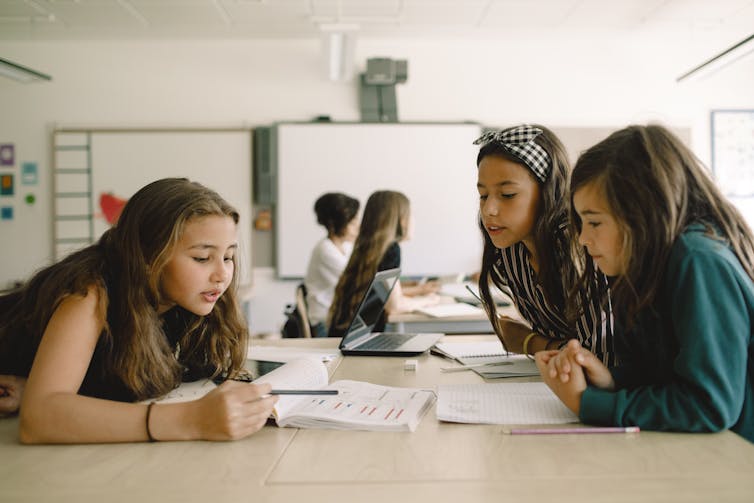
Hawani Negussie, University of Massachusetts

Curious Kids is a series for children of all ages. If you have a question you’d like an expert to answer, send it to [email protected].
Why do us kids have to go to school? – Vanessa C., age 10, Gilbert, Arizona
Kids go to school for many reasons. Where and when depends on their age, location, parental preference and local policies. Parents send their kids to school to expose them to experiences that are different from their own at home and in their communities. Schools are designed to provide spaces for exploration, self-awareness and connection with other kids. Teachers encourage kids to strengthen the skills they have and help them gain new ones as they advance from grade to grade.
I have spent the last 20 years studying and working with children from birth to 21 years of age in a variety of settings. I often think about how to create the best learning environment for children, beginning with preschool. To me, that means ensuring that all children have the opportunity to be in a school that can fulfill their learning needs as well as their physical, social and emotional well-being at all stages of their lives.
Preschool
Around 61% of 3-to-5-year-olds in the U.S. are enrolled in some type of preschool. Because these are critical years for brain development, attending a high-quality learning program is essential.
What makes a good program for young children? Since children learn through play, it’s important for play to be the focus of most activities. It’s also essential for teachers to interact with their young students and respond to each child’s needs.
During this important developmental stage, children also form a sense of self. For example, they might start to think of themselves as a big brother or sister if there’s another child at home. They also begin to connect more deeply with others, learn to communicate their feelings, practice sharing and more. When schools include children’s identity, cultural norms and traditions in the classroom, students feel a sense of belonging and inclusion. This helps children form associations that are important for learning.
Elementary school
Children entering kindergarten at age 5 or 6 can have many different feelings, including nervousness and excitement for this new experience. Perhaps kids have heard adults say that starting kindergarten is the start of “real learning.” But this isn’t the case; kids learn from the day they are born.
With the transition to kindergarten, kids begin to work on personal and social skills, like managing their behaviors and reactions, problem-solving and logical thinking. Kids’ early experiences expand their ideas of how the world works. And as they mature they become better able to understand more complex thought processes, like reversibility, or water turning to ice and then back to water. Another concept they may start to explore is how matter takes the shape of the space it occupies, like sand filling a star-shaped container, and why that happens.
As students advance through elementary school, their reading and comprehension skills improve and they are able to use different resources – from reading books and watching documentaries to taking trips to the museum – to help them understand ideas they encounter inside and outside of the classroom. The education students receive in school further builds on these experiences.

Middle school
During the middle school years, when students are typically between 10 and 13 years old, kids and parents are both starting to interact with school in different ways. Teachers increasingly give more responsibilities to students, and they try their best to personalize what happens in the classroom to students’ talents and strengths.
As students become increasingly independent, parents often pass on more school-related responsibilities to them. Students feel capable and competent when their environment supports who they are and encourages them to apply their existing skills at all levels, but especially in middle school.
Understanding all of the challenges kids are going through – like fitting in, maintaining friendships, puberty and others – can be overwhelming. But middle school also offers opportunities for students to sharpen their skills and talents. Some schools may offer band, theater or robotics and other new opportunities to learn, play and grow alongside their daily studies.

High school
High school is an exciting time for most students because it’s the final gateway to adulthood. Students may take on a heavier academic and extracurricular load as a way to prepare for higher education. In high school, students are able to choose from a range of courses that may include journalism, biology, an advanced foreign language class or world history. At the same time, students may begin taking part in specialized activities like volunteering or trips abroad that could expose them to fields they’d like to study if they choose to continue to college.
The core principle of education is to enable students to become kind, giving and contributing members of their community and the world. While not all students have the opportunity to attend great schools because of unequal circumstances, it is critical all children are afforded education, at home or at school, public or private. Schools are a tried-and-true place where kids gain new skills and knowledge that they continue to use and build on for the rest of their lives.
Hello, curious kids! Do you have a question you’d like an expert to answer? Ask an adult to send your question to [email protected]. Please tell us your name, age and the city where you live.
And since curiosity has no age limit – adults, let us know what you’re wondering, too. We won’t be able to answer every question, but we will do our best.
Hawani Negussie, Chair and Assistant Professor of Early Childhood Education, UMass Global, University of Massachusetts
This article is republished from The Conversation under a Creative Commons license. Read the original article.





Hey! Do you use Twitter? I’d like to follow you if that would be okay.
I’m absolutely enjoying your blog and look forward to new updates.